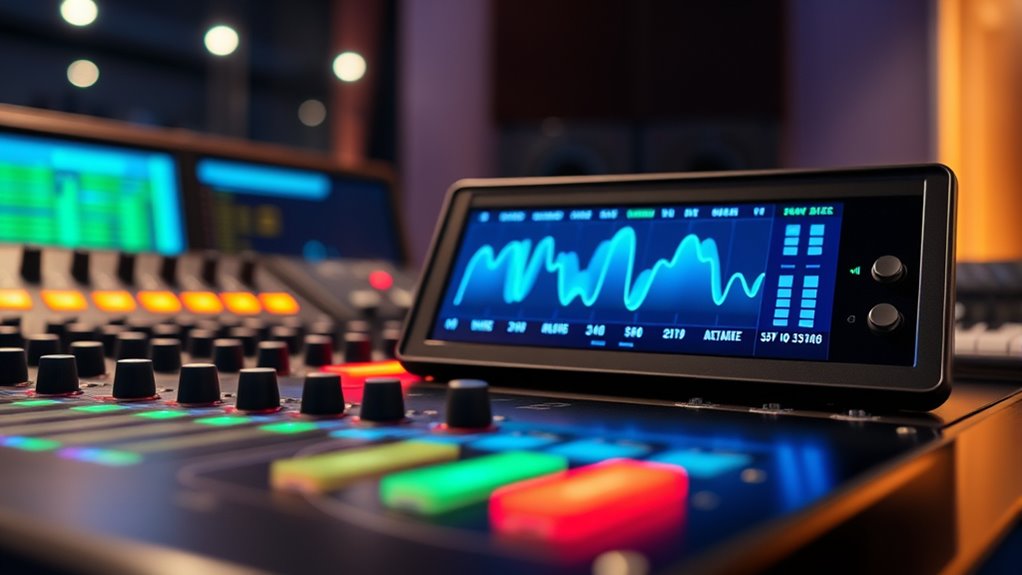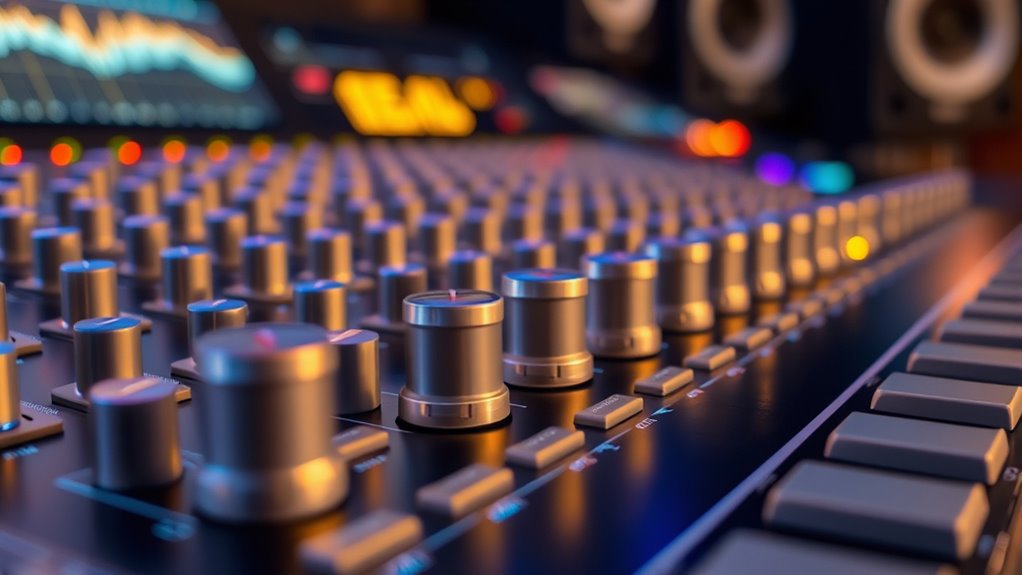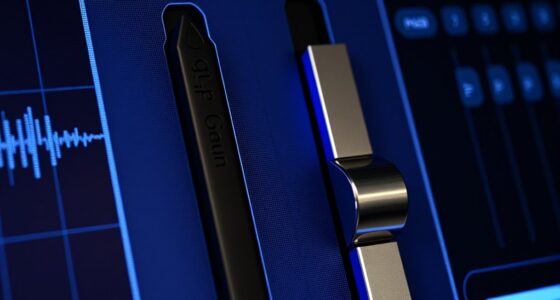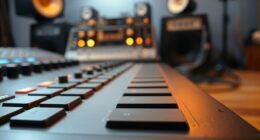To optimize your buffer size for tracking and mixing, start with a small buffer during recording to reduce latency and make sure quick feedback. Switch to a larger buffer when mixing to lessen CPU load and prevent glitches, even if it introduces more delay. Finding the right balance depends on your hardware and project needs—adjust as your work evolves. Keep exploring for more tips to fine-tune your setup even further.
Key Takeaways
- Use smaller buffer sizes during tracking to minimize latency and enable real-time monitoring.
- Switch to larger buffer sizes during mixing to reduce CPU load and prevent dropouts.
- Test different buffer settings to find a balance between low latency and system stability for your hardware.
- Adjust buffer size based on project complexity and hardware capabilities for optimal performance.
- Regularly revisit buffer configurations as project needs evolve to maintain smooth recording and mixing workflows.

Have you ever wondered how the size of your buffer impacts system performance? When you’re tracking or mixing audio, buffer size plays a critical role in how smoothly your workflow runs. If your buffer is too small, you might encounter increased audio latency, causing a noticeable delay between your input and what you hear. This delay can make real-time recording and monitoring frustrating, as you struggle to stay in sync with your project. On the other hand, setting a buffer that’s too large can reduce latency but may put unnecessary strain on your CPU load, leading to sluggish performance or glitches during playback. Finding that perfect balance is essential for a seamless experience.
Adjusting buffer size balances low latency and system stability for optimal audio performance.
A smaller buffer size minimizes audio latency, which is vital when you’re recording or performing live monitoring. When latency is kept low, you hear your input almost instantly, allowing for more accurate timing and better performance. However, reducing the buffer size increases the demand on your CPU because the system must process audio data more frequently. This heightened CPU load can cause your system to struggle, especially if you’re running multiple plugins or using a complex project. If your CPU can’t keep up, you might experience glitches, dropouts, or crackles, disrupting your workflow and making it harder to stay in the groove.
Conversely, larger buffer sizes ease the burden on your CPU by allowing it to process chunks of audio data more comfortably. This reduces the risk of glitches and improves overall stability, especially on less powerful systems. But the tradeoff is increased audio latency, which can be a problem when tracking new recordings or trying to perform in real-time. If you’re overdubbing vocals or guitar, this delay can make it difficult to stay in sync with the rest of your session. Thus, during tracking, you want to minimize latency by choosing a smaller buffer, but for mixing or playback, a larger buffer helps prevent system overloads and ensures smooth operation.
Adjusting your buffer size is a balancing act that depends on your specific needs and hardware capabilities. Monitoring your CPU load while testing different buffer settings helps you find the sweet spot. Aim for a buffer size that keeps latency low enough for real-time performance but doesn’t push your CPU to its limit. Remember, each system and project is unique, so what works for one setup might not be ideal for another. Regularly revisiting your buffer settings as your project evolves guarantees optimal performance, giving you the ability to track, monitor, and mix with precision and confidence. Additionally, understanding your system capabilities is crucial for optimizing buffer size effectively.
Frequently Asked Questions
How Does Buffer Size Affect CPU Load During Tracking?
You’ll notice that smaller buffer sizes increase CPU load during tracking because they reduce hardware latency, allowing for quicker response times. However, this can sometimes cause plugin stability issues if your system can’t keep up. Conversely, larger buffer sizes lower CPU strain but add latency, making real-time monitoring less responsive. Adjusting buffer size helps balance hardware latency and plugin stability, ensuring smoother tracking without overloading your CPU.
Can Buffer Size Settings Impact Audio Latency?
Did you know that increasing your buffer size can reduce latency by up to 50%? Yes, buffer size settings directly impact audio latency, making your recordings more responsive. When troubleshooting buffer size issues, adjusting it helps find a balance between latency reduction techniques and CPU load. Smaller buffers lower latency but strain your CPU, while larger buffers increase latency. So, optimize your buffer size for smooth tracking and mixing sessions.
What Are the Signs of an Improperly Optimized Buffer Size?
If your buffer size isn’t optimized, you’ll notice signs like audio glitches, dropouts, or delayed responses, which indicate latency issues. Many fall for buffer size myths, thinking bigger always means better, but this can cause latency misconceptions. Conversely, too small a buffer can overload your system, leading to crackling sounds. Pay close attention to your system’s performance, and tweak the buffer size carefully to balance latency and stability.
How to Balance Buffer Size for Both Mixing and Tracking?
Imagine catching the perfect balance—you’re optimizing buffer size for both tracking and mixing. To do this, start with a low buffer during tracking for minimal latency, then increase it during mixing to reduce plugin latency and ensure hardware compatibility. Switch smoothly between these settings based on your workflow, and keep an eye on plugin latency, so your system remains responsive and efficient without sacrificing performance.
Does Buffer Size Influence Plugin Performance?
Yes, buffer size influences plugin performance. A smaller buffer size can cause instability, leading to glitches and crashes, especially affecting plugin compatibility during tracking. Conversely, a larger buffer provides more stability but may introduce latency, impacting real-time mixing. Adjusting buffer size helps balance plugin performance and stability, ensuring your system runs smoothly. Experimenting with different buffer sizes allows you to find the most suitable setting for your specific setup.
Conclusion
By fine-tuning your buffer size, you’re fundamentally tuning an instrument to achieve perfect harmony. Too small, and you’ll face discordant glitches; too large, and the melody gets delayed. Finding that sweet spot ensures smooth tracking and mixing, like a well-conducted orchestra. Remember, the right buffer size isn’t just a setting—it’s the rhythm that keeps your music flowing seamlessly, allowing your creativity to shine without interruption or distortion.










